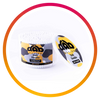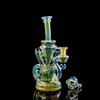Enter Dab Nation’s Museum of Glass Art Decorative Techniques
There’s a popular philosophy in the art world that encourages artists to change their mediums every so often to keep things fresh and full of vitality. But we can’t imagine many glass artists walking away from the blow torch with such a wealth of techniques keeping things fresh and provocative. Glass art is a surprisingly large umbrella, looming over a diverse array of decorative techniques that could take even the most proficient artists a lifetime to master. For this reason, you’ll often find glass artists settling on one or two techniques they really enjoy and perfecting those as signature features of their work. When you come to Dab Nation, it’s almost like visiting a museum or art gallery packed with stunning examples that serve as the result of these decorative methods. Today, we’re going to discuss some of the more popular glass decorating techniques we see in everything from our dab rigs and carb caps to pendants and hand pipes. Knowing the techniques used to create this glass art can help you out immensely when searching for a piece of your own.
Linework
Sometimes referred to as glass ribboning, linework involves the decoration of glass using smaller bands of colored glass tubing. Another popular technique, this one dating all the way back to the 1st century, linework is considered by many to be the baseline for glass decorative methods. Anyone from novice glassblowers to experienced glass art veterans can use this technique in effects that run the full spectrum between minimal simplicity and masterful complexity. You’ll see linework used in even the cheapest of bargain bin hand pipes all the way up through heady collector’s pieces, often distinguished by patterns of contrasting color reminiscent of a candy cane pattern though we’ve seen glass ribboning used in highly creative patterns as well. It’s such a prevalent mode of glass decoration that it can be difficult to narrow down an example, but Windstar’s Southwestern Dab Rigs show how linework can almost be used like a form of glass illustration, offering plenty of control for glass artists.
While linework can take on all kinds of different appearances, one very distinctive design that makes up a sub-category of linework is wig wag. Wig wag usually incorporates several complex layers that are then worked into a zig-zagging pattern. The perfect example of wig wag (because it’s nothing but wig wag) is the heavily saturated Fully Worked Wig Wag Dab Rig from Nitro Glass. J. Spaga offers another creative use of wig wag, punctuating the Wig Wag Tube Dab Rig with the decorative technique.
Dichro
One of our favorite decorative techniques in glass art serves up space age psychedelia with its shifting iridescent veneer. Dichroic glass may have had its start in the color changing glass of the 4th century, but its evolution over the years wound its way through the laboratories of NASA where the material we recognize today as dichroic glass was developed. Often referred to simply as “dichro”, this material gets its unusual visual properties by adding layer upon layer of glass along with micro-layers of metals or oxides. Perhaps one of the best examples of dichroic glass art that we offer in our shops is the 14mm UV Dichro Slide from Sandberg Glass, presenting a shimmering bowl piece that looks a soothing blue from one angle and a verdant green from the next.
Crushed Opal
When the sunlight beams through the Dab Nation shop window at just the right angle, you can’t help but turn your head at the light reflecting in the glittering veneer of our pieces that incorporate the crushed opal technique. The use of opal for decorative purposes has been building rapidly in popularity over the years, though using crushed opal mixed in with frit is a wildly different animal than simply applying a whole opal. When opal is crushed using a mortar and pestle or similar method, it can then be mixed in with frit (with black being a popular color choice for the way it contrasts with the crushed opal). This mixture is then incorporated into a glass tube which is typically spun to create an even distribution of opal and frit. The Crushed Opal Portal Dab Rig and Crushed Opal Tube Mini Rig, both from DBE503, are perfect examples of this technique, offering a stem that’s at once dazzling in its glittering reflection and murky in its stark void, a contrast reminiscent of the furthest reaches of outer space. This beautiful balance of flash and stoicism is further reinforced in the stem of the retrofuturistic Happy Time Glass Crushed Opal Time Tube Dab Rig. Crushed opal can also take on a colorful, carnivalesque quality that contrasts beautifully with the dark glass, perfectly exemplified in Whitney Harmon’s Heady Glass Dab Rig.
Reticello and Its Variations
If you like your glass art to feature complex designs with ornate, detailed patterns, you’re no doubt a fan of reticello. This technique involves thin glass tubing laid down in criss-cross patterns that are then twisted as the torch is applied to create an even, geometrically sound curve. But we’re only halfway there. Now, a second layer of thin tubing is applied in a crosshatch method with heat once again being applied before a twist, this time to create a curve in the opposing direction. The natural geometry creates stunningly complex results that seem to illustrate perfection. It can be difficult to imagine but one look at the gliding and gracefully intersecting delicate white lines saturating the chamber of the Daveman Banger Hanger Dab Rig should give you an idea of the reticello aesthetic. Reticello can be colorful too as evidenced by the rainbow electricity that characterizes the chamber of the CFL Retti Banger Hanger from Likewise Glass.
Reticello is a technique popular enough to have inspired its own sub-techniques. Fumicello, as the name would suggest, incorporates fumed glass for a soft ethereal emanation, whereas fillacello finds the glass artists literally “filling” in the gaps between the lattice-like reticello pattern. You can notice the differences in the fumicello technique between the otherworldly gilded glow of our Fumicello Slurper Set from Waugh Street, Fumed Fractal Slurper Set from Andrew Tischler Glass, and the light and warm emanation of the Chuck Millions Travel Dab Rig. A chillier take on fuming can be seen in the silvery fumicello of the King Leo Glass Marble. Funky Filla’s Slurper Set illuminates a perfect example of the more-is-more approach to fillacello with a flowery aesthetic in intricate layers of color. For a less abstract take on fillacello, there’s no better example than the cold color geometry of Sir Pyro Glass’s Filla Recycler Rig.
Dot Stacking
Dot stacking is achieved when glass tubing of varying colors are layered over one another. Everything from mesmerizing layered dots to complex designs can be created using the dot stacking technique. You can find liberal use of the dot stacking method in the decorative disc of the Oddball Encalmo Tube Wax Rig that finds tasteful punctuations of yellow and blue-green dots compounded upon one another. The result is a perfect nexus point between pop art and glass art.
Millie
The closest thing to giving a glass dab rig a tattoo, millie (short for millefiore) is a technique that finds detailed glass illustrations, often references to pop culture, injected into the glass of the rig or pipe. It’s achieved by the glass artist initially creating a low res image of the character or symbol through a layering technique, then stretching the glass so that the image is dramatically condensed for higher resolution. The resulting rod is then cut into thin slices of glass that almost look like miniature stickers. Some pieces of millie are deliberately more stout so that, when cut into thin slices, the result is a larger image, usually referred to as a millie coin. If you want a crash course in recognizing millie, look no further than the Glass Chaos Tubes of Pee Jay Taylor; dab rigs employing the classic bong design that are completely saturated with psychedelic color and plenty of floating millie that reference iconic pop culture figures. You can get acquainted with millie under more controlled circumstances by checking out the Millie Back Tube from NES which features an orderly line of marbles each displaying its own distinct piece of millie.
Chip Stacking
You may think chip stacking would be similar to dot stacking but it’s closer in style to millie. Sometimes referred to by its more scholarly name “murrine”, chip stacking finds the artist employing the familiar millie technique of creating a layered glass image almost akin to a glass illustration before stretching it to get that higher resolution result. However, chip stacking typically finds the artist slicing thicker slabs (or chips) of glass from the resulting rod. The thickness can be important because chip stacking typically involves the chips forming the walls of the glass art itself as opposed to simply being added for decorative embellishment (as we’d see most commonly with millie). The result is almost like glass quiltwork; a composite piece of several different glass chips working together to form a greater whole. You’ll find generous use of chip stacking in full display on the Cajun Glass Helio Sphere Dab Rig. There’s a lot going on with this piece, but you can see the chip stacking in all its glory in the psychedelic patterns across the stem and midsection.
Glass Marbling
Glass marbling is a fairly common technique in everything from dab rigs to hand pipes, and has a history that reaches back to 15th century Venice. At least two bands of color are merged together in such a way as to create an erratically wandering marbling effect; a classic of psychedelic visual inspiration. A gorgeous example of the psychedelic majesty of marbling can be found in the kaleidoscopic splendor of the Joey B Mini Jammer.
Sculpting
Some of our headiest pieces owe their distinctive style to the sculpting technique. For this method, creators of glass art use a variety of tools to work and shape the form of the glass. Glass sculpture is at the heart of some of the most memorable heady pieces in our shops and, when combined with some of the other techniques on this list, can produce some of the most bold and visually stunning glass art on the market. A perfect example of glass sculpting at its finest, Habit Glass’s Empire Hammerhead Shark Recycler Rig shapes deep purple borosilicate into a fluid arc of graceful complexity, indicating an aqueous swaying motion in its carefully constructed contours. Cal Smith’s Cone Jammer provides another sterling example of glass sculpting in the cartoonishly warped features of a faded duck doubling over. Sometimes, the sculpting element of a dab rig is so focused on a vision that you will have trouble recognizing the rig itself, as is the case with one of our headiest pieces, the Linework Ganesh Dab Rig from Hendy Glass which depicts a psychedelic representation of a revered member of the Hindu pantheon. Catalyst Glass takes a less reverent subject matter, a cigar-chomping chimp, and renders it with deft sculpting skill in their Smokin’ Chimp Dab Rig. One of our most hotly discussed recent arrivals, the Crushed Opal Parasaurolophus Dab Rig from the always impressive Amorphous Symphony depicts a standing dinosaur poised for a time-transcending sesh. But glass sculpting isn’t just reserved for heady glass dab rigs. Cadoo’s Karma Toad Dry Pipe shows how delicate sculpting techniques can be incorporated into tiny hand pipes with a depiction of a toad in the midst of a surreal tongue-lashing.
Fuming
If you’ve ever noticed glass art that takes on an almost hazy glow, you’re probably noticing a technique called fuming. This popular glass decorative technique requires the glass artist to work vaporized metal into the glass by releasing the fumes into the torch flame. The metal will then bond with the glass for the otherworldly effect. You’ll most commonly find fumed glass art incorporating silver, gold, or platinum as the bonding metal. The Eric Runes Inside Out Hammer Bubbler is an immaculate example of golden fuming with its unmistakable rich radiance. An equally heavy dose of fuming contributes to the otherworldly glow of the Juicy Bones Bubble Dumper which looks golden in some lighting while a silvery blue in others. But perhaps one of our most elegant examples of heavy gold fuming comes from AkillArt with the Fume Deco “Genie” Water Pipe that almost looks like it was cast from gold at the base.
Encalmo
Sometimes the most impressive results in glass art come down to flawless symmetry. For that aesthetic, few techniques can compete with the perfection of the old Venetian technique called encalmo. Pieces that employ this method of decoration find uniformity in painstakingly stacked bands of colored glass. Kimmo Glass’s Full Color Mini Vase Tube presents the encalmo technique in masterful simplicity with soothing blue sections contrasting against darker translucent glass. The Worked Mini Tube Set of Simpal Glass shows the effect of incorporating wig wag designs and color-reactive glass into the encalmo technique. Cajun Glass tries the technique with crushed opal for stunning results on their Helio Sphere Dab Rig design. Yet another example of tasteful encalmo is found with the Totem Glass Cup Jammer, where the technique bisects its rich, colored glass with a clear midsection.
UV-Reactive Glass
Simply using UV reactive glass may not seem like a decorative technique per se, because the glass tubing isn’t likely created by the artist but instead purchased by the artist. But incorporating UV-glass into a dab rig tactfully is where the artistic skill really comes into play. Any glass, UV-reactive or otherwise, can anneal at different rates than other colors, resulting in warping. Glassblowers must overcome that challenge no matter what, but combining UV-reactive with standard glass can add an aesthetic pitfall as well. An instantly recognizable example of UV-reactive glass done well is found in the radioactive green glow of the Unity Glass Works 2-Hole with Opal Slide.
Coldwork
As the name would suggest, coldwork techniques refer to any decorative methods executed outside of the heated blast of the torch. Coldworking opens the doors to all kinds of textural manipulation that would be unreachable through heated glass blowing methods. It can also be used to cut different shapes into glass, creating embossed effects and much more. A variety of tools can be used to create coldworked glass art, often involving techniques such as grinding, etching, sandblasting and engraving. Unity Glass works frequently uses coldwork techniques in their glass art with their Orb Wax Rig being a perfect example. It’s wild animal print chamber actually has an embossed texture achieved through sandblasting. Unity are also known to use coldwork in fashioning the facets of their gem-like Slurper Marbles, with Shipley Glass providing equally stunning work with the same technique for their Funky Filla Slurper Marbles.
You are probably feeling like you just washed up from a veritable ocean of glass decorative techniques, but these are just the most prevalent that you’ll find in either of our Dab Nation shops. We could easily run a whole humanities course just focused on all of the different methods of decoration in glass art. But for now, one of the best sources of knowledge is our team of glass experts who can take you on your own personal guided tour of these techniques or, if you already have a favorite, help you find a piece that speaks to you to add to your own glass art gallery at home.


























Comments
Leave a comment